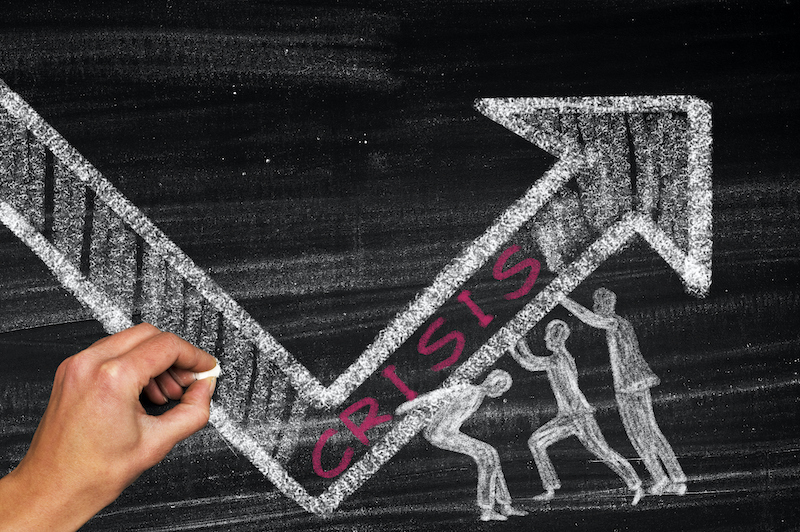Dynamic Crisis Leadership and Business Resilience During COVID-19

A Different Kind of Crisis Requires Different Planning and Response
We are thankful for the years of experience we have guiding government and commercial clients through resiliency and disaster planning preparation. We call it Alternate Futures® Scenario Planning, and through it, we help our clients “Imagine If.” In recent weeks, we at Toffler Associates have been practicing what we preach and using it with our firm’s response planning while in the thick of the COVID-19 crisis.
Like many of you, we needed to make difficult choices for our business. Using our own methodology, we’ve kept possible ends in sight while making the necessary near- and long-term business decisions to navigate our firm and our clients through this crisis. Exploring our own worst-case scenarios helped me understand the depths of impact and how far-reaching our decisions would be as they rippled out through our organization’s ecosystem.
As I’m sure you are well aware, practicing dynamic crisis leadership and business resilience during COVID-19 is tough.
We, as leaders, are forced to prioritize between keeping employees, preserving liquidity and the continuity of our operations and client service. As our values around compassion, integrity and loyalty are being put to the test, leaderships need to align quickly.
Resilient leadership in a crisis takes great courage.
Over the last few weeks, we have seen how our clients are adapting to the dynamic planning environment needed for a pandemic compared to the plans they had for events such as natural disasters, cyber-attacks and active shooters. There are some commonalities worth examining in the tough questions they are struggling to answer, including:
- What information is relevant to making decisions, and what is noise distracting my organization or causing potential overreactions?
- How do I set priorities and make decisions with all this uncertainty?
- How will this end and what will be different?
- How should my leadership team manage productivity, morale and stakeholder engagement for a prolonged time frame of 3-18 months, with abnormal operations?
- How effective is the daily crisis call and is it resolving issues, making decisions, and providing direction?
- How does the crisis response team represent diverse stakeholders and perspectives of the organizations?
- How should my leadership team or crisis response team evolve to be more agile?
A different type of response planning and crisis leadership is required – dynamic crisis leadership.
Most crisis planning exercises address responses to an event and not to a long-duration pandemic which produces new information daily and weekly. The complexity and global nature of COVID-19 create multiple layers of uncertainty with respect to duration, geography, scale and finances, as well as the human and psychological impacts. Different activities are required to chart a course. Combining dynamic crisis leadership practices with decision making based on business resiliency principles provides an agile method for leaders during the pandemic.
There is no best practice for dealing with a pandemic like COVID-19. We have learned a lot as our firm is managing through COVID-19 and by speaking with clients. And, we have used the new insights to update our approach for crisis response and leadership. The approach is aligned to a proven planning process utilized by the military as a methodical way to navigate through trying times. A series of questions can be used within the Crisis Response Team or at an organizational level to begin the process.
Prepare and Understand
- What are the guiding principles for leadership decisions?
- What facts and information do you know and how do you scan for the fact base?
- What facts and information do you need to understand or make assumptions?
Analyze
- What is the problem statement we must solve for right now and long term?
- What scenarios need to be analyzed and models created?
- What are implications of the scenarios?
Decide and Execute
- What are decisions and action plans for now, 30 days, 60 days, etc.?
- Who is empowered to make what decisions?
- How are you communicating transparently to employees, customers, constituents, partners, etc.?
- How are you maintaining trust with your stakeholders?
- What accommodations need to be made for implementing in a crisis environment?
Monitor and Update
- How are you sensing changes to the fact base?
- What internal and external indicators are you monitoring?
- How are you periodically reviewing the assumptions and fact base to adjust plans?
Assumptions are necessary to effectively plan a response. It’s important to identify the facts and known information, as well as what is unknown, to be effective. Scenarios should be based on your planning goals and examined with an analysis of the required decisions and implications. Over the course of days, weeks or months, the stated assumptions will be proven or disproved, causing the fact-base to be updated and the crisis response plan to be adjusted. Thus, keeping it dynamic.
This Nietzsche quote comes to mind when thinking about the chaos often displayed by unprepared leadership teams: “The most basic form of human stupidity is forgetting what we are trying to accomplish.” Leaders need to keep this top of mind while navigating the crisis and develop a plan that achieves the goals while balancing realism and optimism.
We are on this learning journey together. Please let us know how you are navigating the COVID-19 crisis.
{{cta(‘8f7815e1-b0f9-4dba-86f1-0d46aa023c6d’)}}
Other COVID-19 resources:
- Categories
- Strategic Planning
- Workforce of the Future


 About the Authors
About the Authors